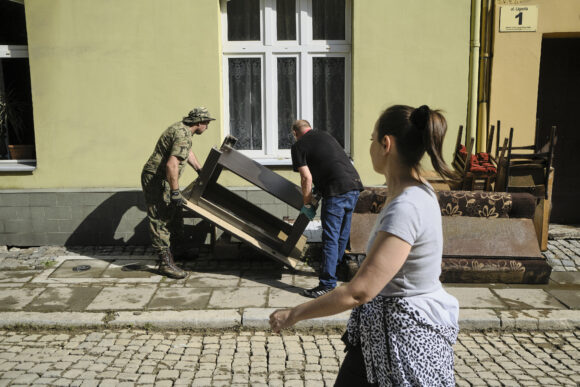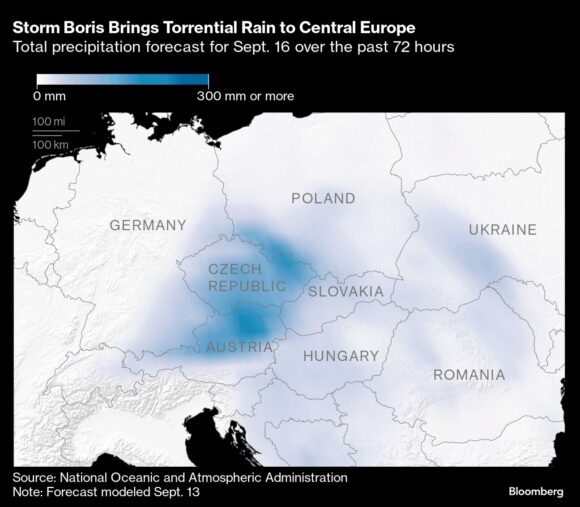Cities from Budapest to Wroclaw in Poland are racing to build up their defenses as floodwaters peak over the coming days.
The floods that unleashed destruction across central Europe are receding in many places after the torrential rain from Storm Boris passed, but towns and villages downstream are braced for rising river levels. More than 20 people have died across the region.
Drawing on the lessons learned from massive floods in 1997, countries such as Poland and the Czech Republic have invested in control systems and retention reservoirs. That’s curbing some of the worst flood impacts, though the situation in Austria is complicated by meltwater after as much as 150 centimeters (59 inches) of snow fell in parts of the Alps over the past week.
Climate change is increasing the intensity and frequency of extreme weather events, including violent storms. Slow-moving Storm Boris dumped record rainfall in places like Lower Austria after cold air from the north collided with moisture drawn from the Mediterranean Sea, which had been heated to record levels over the summer.
Europe is the fastest warming continent, with temperatures rising at around twice the global rate. That makes it particularly vulnerable to extreme weather events, from the floods in central Europe to the wildfires still burning in northern Portugal and Greece.
“We have a Europe that is simultaneously flooding and burning,” said the European Union’s crisis commissioner, Janez Lenarcic. “This tragedy is not an anomaly. It’s fast become a norm for our shared future.”
Europe must step up its response after the annual cost of disasters surpassed €50 billion ($56 billion) in 2021 and 2022, more than six times the average in the 1980s, Lenarcic told the European Parliament in Strasbourg.
The Czech Republic has requested support through the EU’s crisis mechanism, while an offer has also been made to Slovenia.
ING Bank put the preliminary estimate of the total damage in the Czech Republic alone at around 0.5% of gross domestic product, or about 40 billion koruna ($1.8 billion).
The floods have triggered emergency measures in Austria, the Czech Republic and Romania, after thousands of people were evacuated. In Lower Austria, 24 towns are still difficult or impossible to access via road.
St Poelten, the capital of Lower Austria, had 409 millimeters (16 inches) of rain over five days, almost double the previous five-day record, according to weather service data going back to 1937.
This is a modal window.The media could not be loaded, either because the server or network failed or because the format is not supported.
While many parts of the region start clean-up efforts, Budapest is preparing for peak flows in the Danube, which may only come as late as Friday. Authorities have closed sections of road and rail tracks along the river.
Further downstream, Romanian authorities are also monitoring the Danube, with flows expected to double by early next week.
The death toll in Poland rose to seven as the rising Oder river threatens Wroclaw, the country’s third largest city and the epicenter of massive floods 27 years ago.
Prime Minister Donald Tusk’s government announced on Wednesday it will provide financial assistance for 12 months to mortgage-holders who lost their property. It has also consulted banks about the suspension of loan repayments for other types of loans.
The Czech Interior Ministry said three people have been confirmed dead, while seven more are still missing.
Some roads and railways remain closed but water levels have begun to recede in many of the worst-hit areas. The army has deployed soldiers and heavy machinery to help with clean-up works.
Top photo: Residents remove furniture damaged by floodwaters following heavy rainfall in Nysa, southwestern Poland, on Sept. 17. Photographer: Bartek Sadowski/Bloomberg.
Was this article valuable?
Here are more articles you may enjoy.



 California Insurance Commissioner Provisionally OK’s State Farm’s 22% Rate Request
California Insurance Commissioner Provisionally OK’s State Farm’s 22% Rate Request  Greenpeace to Pay $660 Million in Damages to Texas Oil Firm
Greenpeace to Pay $660 Million in Damages to Texas Oil Firm  Teen’s Suicide Turns Mother Against Google, AI Chatbot Startup
Teen’s Suicide Turns Mother Against Google, AI Chatbot Startup  Insurers Have Paid $12B in Claims for LA Wildfires, Report Shows
Insurers Have Paid $12B in Claims for LA Wildfires, Report Shows 